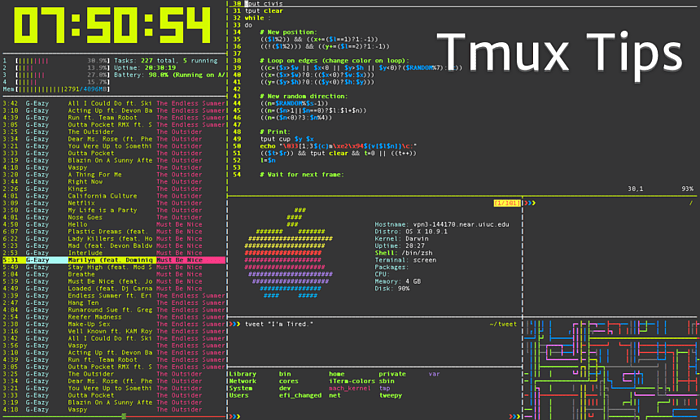

- #Tmux new window how to#
- #Tmux new window install#
- #Tmux new window serial#
- #Tmux new window windows#
#Tmux new window how to#
If you’re wondering how to close a pane, simply quit that specific command line shell using exit, logout, or Ctrl+d. To immediately move to a specific window (0-9), hit Ctrl+b followed by the window number.If you want to move to the next window, hit Ctrl+b, n.To move to the previous window, hit Ctrl+b, p.(Keen readers will see this in the screenshot above.)
#Tmux new window windows#
Notice that the status bar now shows two windows running.
To create a new window, hit Ctrl+b, c. You can also run multiple windows in your session. So far, this example has only used one window with multiple panes. The display will look something like this: Run top in the bottom right pane to monitor processes on your system. Start vi in the bottom left pane to edit a text file. Use ls to show directory contents in the top pane. 
Now, try using the panes to run different commands. During this time, you can hit the number for the pane you want. To navigate around panes, do any of the following:

Notice the highlighted border around your current pane. The new bottom right pane is your active pane. Now you have three command line panes in the window.
Hit Ctrl+b, % to split the current pane vertically. Notice that the new bottom pane is your active pane. Now you have two command line panes in the window, one on top and one on bottom. Hit Ctrl+b, “ to split the current single pane horizontally. All commands by default start with Ctrl+b. Now let’s experiment with a few simple commands to create additional panes. Stretch your terminal window to make it much larger. The information bar will change as you add more windows and panes to the session. Also, the date and time on that particular host is shown. “hostname” – the hostname of the tmux server you’re using. * – Shows that you’re currently in this window. The current directory is ~ (the home directory). The terminal in the active pane of the window is owned by username at hostname host. – Information about the first window of that session. The server tracks all sessions whether they’re still alive or not. – You’re in the first session that was created by the tmux server. 
#Tmux new window install#
sudo dnf -y install tmuxĪt first, it might seem like nothing happens, other than a status bar that appears at the bottom of the terminal: You’ll need to have sudo setup for your user account ( check out this article for instructions if needed). To get started, install the tmux utility on your system.
A pane is one part of that view, often a terminal session. A window is a single view - that is, an assortment of things shown in your terminal. In other words, it can break your single terminal session into multiple sessions. The tmux utility gets its name from being a terminal muxer, or multiplexer. But what if you could break up that terminal into multiple sessions? This is precisely where tmux is handy - some say indispensable. This wastes space, especially on large monitors and high resolution laptop screens. Even with a large terminal window, the entire window only shows one session. However, it only shows you one command line session at a time by default. The terminal gives you access to your whole system, as well as thousands of powerful utilities. Tmux is included in the OpenBSD base system, and is available as a package for many other Unix-like operating systems.Some Fedora users spend most or all their time at a command line terminal. Vertical and horizontal Window split support. Different command keys-it is not a drop-in replacement for screen, but can be configured to use compatible keybindings. #Tmux new window serial#
Lack of built-in serial and telnet clients.vi-like or Emacs command mode (with auto completion) for managing tmux.Window can be linked to an arbitrary number of sessions.Menus for interactive selection of running sessions, windows or clients.It allows users to start a terminal session with clients that are not bound to a specific physical or virtual console multiple terminal sessions can be created within a single terminal session and then freely rebound from one virtual console to another, and each session can have several connected clients. Tmux includes most features of GNU Screen. It can also be used to detach processes from their controlling terminals, allowing remote sessions to remain active without being visible. It is useful for running more than one command-line program at the same time. It allows multiple terminal sessions to be accessed simultaneously in a single window. Tmux is an open-source terminal multiplexer for Unix-like operating systems.








 0 kommentar(er)
0 kommentar(er)
